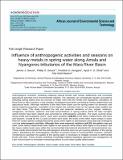Influence of anthropogenic activities and seasons on heavy metals in spring water along Amala and Nyangores tributaries of the Mara River Basin

View/
Publication Date
2018-07Author
Owuor, James J.
Owuor, Philip O.
Kengara, Fredrick O.
Ofula, Ayub V. O.
Matano, Ally-Said
Metadata
Show full item recordAbstract/
Anthropogenic activities, including replacing natural forests with human settlements and increased agricultural activities have environmental impacts. The activities can contaminate aquatic ecosystems including spring waters that are sources of major rivers like the Amala and Nyangores, tributaries of Mara River in Mau Complex. In the complex, forestlands have been converted to human settlements and agricultural lands. Although residents of the Mara River Basin use the spring waters for domestic and animal watering purposes, evaluation of the impact the activities have on the spring water quality has not been done. This study evaluated the site and seasonal variations of zinc, copper, selenium, manganese, chromium, cadmium and lead concentrations in spring waters within the Mau Complex where forests have been cleared and converted to anthropogenic activities. The study covered areas along Amala and Nyangores rivers. There were variations (p≤0.05) in the heavy metals levels with sites and seasons. Except for Mn, Cu and Cd which were lower, the levels of the other heavy metals in water from the control points (undisturbed forest areas) were higher in downstream areas that had undergone massive anthropogenic activities. Although there were seasonal variations (p≤0.05), the pattern was not clear. Some heavy metals levels were higher in wet seasons while others were higher in dry season. But the heavy metals levels were within the recommended international standards for domestic/animal use. These results demonstrate that the anthropogenic activities were not yet causing pollution of the spring waters. Maintaining the anthropogenic activities at present levels is recommended. However, periodic monitoring to ascertain the quality of the spring water is necessary to mitigate increase to detrimental levels with time. These results contribute knowledge helping regulatory agencies and management of Lake Victoria basin to formulate monitoring polices to curb water quality deterioration.
Collections
- Department of Chemistry [339]
